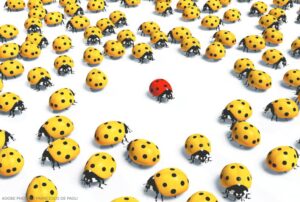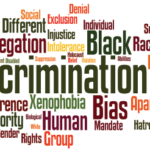 “I’m actually from Iowa. Where do you hail from?” I replied, in the friendliest tone I could muster. Many readers may already know the context, but I’ll rewind a few moments to clear up any ambiguity.
“I’m actually from Iowa. Where do you hail from?” I replied, in the friendliest tone I could muster. Many readers may already know the context, but I’ll rewind a few moments to clear up any ambiguity.
I was in clinic and talking with a kind lady with joint pain. While I was in the middle of examining her joints, she smiled at me and asked, “Doctor, where are you from? Your English is really good.” Having answered this same question literally hundreds of times during medical school, residency, fellowship and academic practice, I instinctively responded with my stock reply.
This is a classic example of a microaggression, a term used to describe “brief, everyday exchanges that send denigrating messages to certain individuals because of their group membership.”1 In this case, my patient had—most likely unintentionally—tagged me as an outsider due to my status as an Indian American, which, I should add, makes me no less American or Iowan than anyone else.
Despite their name, microaggressions are not tiny: Their cumulative volume is often significant, and even in apparently small doses, microaggressions are sufficient to cause significant negative effects on well-being. But what are these microaggressions, why are they important to acknowledge, and how do we address them?
Let’s rheuminate.
Microaggressions Under the Microscope
Although microaggressions appear to have an extraordinarily long history, the term was first coined in 1970 by Chester M. Pierce, a professor at Harvard University, Boston, with specific reference to the dismissive behavior inflicted upon African Americans. Over the past half-century, with greater awareness, the term has expanded to include socially marginalized groups at large—including such aspects of identity as gender, sex, sexual orientation, disability, age, body shape, class, religion and more—and to include behavior that may be otherwise seen as well-intentioned.
The term is not without its own controversies. Microaggressions have very real effects, but they are difficult to study due to their subjective nature. Because microaggressions are simultaneously ubiquitous but invisible, explaining what a microaggression is takes a disproportionate effort. The concept is also wrapped up in sensitivities that make it difficult to talk about, despite the importance of broaching such conversations.
According to D.W. Sue, professor of psychology and education in the Department of Counseling and Clinical Psychology at Teachers College, Columbia University, New York, microaggressions can be categorized in four groups: microassaults (i.e., explicit verbal or nonverbal derogation), microinsults (i.e., hidden insulting messages to the recipient), microinvalidation (i.e., communications that dismiss the experiential reality of the recipient) and environmental microaggressions (i.e., insults or invalidations at the systemic level).
Of course, things in real life are rarely this cut and dried, and these categories overlap a great deal. In my case, invalidating my sense of belonging is a microinvalidation, and judgment of my spoken English can be seen as a microinsult.
Microaggressive or Passive Aggressive?
Or were these microaggressions at all? I’ve drunk plenty of cups of chai discussing this scenario with my fellow Indian American colleagues because it is so common. There is no uniformity in their responses, which range from anger to dismissal to bemusement. While I have not explicitly asked people who ask me “Where are you from?” to explain their reasoning, it seems like they would not see it as aggression but rather as simple curiosity. Moreover, each instance is subtly different, with nuances that make it hard to distill into an objective, concrete reality.
Another issue is also at play, one that makes me uncomfortable discussing this topic. I am not truly from a socially marginalized group, as the original term emphasized. Yes, I am Indian American, and 50% of Indian Americans have experienced discrimination over the past year, but I come from a community that is, by and large, not socially or economically disadvantaged.2,3 Just as importantly, I don’t identify as being from another socially marginalized group that would be even more likely to be on the receiving end of microaggressions. So, truth be told, as far as microaggressions are concerned, I have certainly not experienced the worst of it.
It’s also not just my own identity that plays into the difficulty of defining and characterizing a microaggression. As mentioned, I live in Iowa, the exemplar of Midwest nice, which is ingrained within the culture to avoid conflict, minimize awkwardness and uphold politeness. Passive aggressiveness is a veritable language throughout many areas of the U.S. and the world, with its own set of unique idioms that can be interpreted ambiguously. When does this passive aggressiveness veer into microaggression?
There’s no clear answer, but a thought experiment may be in order. If I were not visibly brown, would the question “Where are you from?” or the statement “Your English is really good” be passive aggressive? I’m not sure. What if the patient were also brown? Perhaps. Such permutations don’t really provide a lot more clarity unless taken to the extreme.
Microinterventions
Regardless of what we may call it, if a statement makes you feel uncomfortable, it’s hard not to react. In the recent past, the advice, at least in my institution, has been to remain inactive or passive. When I complained to a senior colleague about an unfortunate interaction, he let me know that the best course of action was to “give them an out.” And certainly that’s an option to deal with microaggressions, which has the short-term benefit of de-escalation, but it may not be a viable long-term strategy.
Enter microinterventions. D.W. Sue talks about microinterventions as a potent strategy to address microaggressions.4 Microinterventions have four strategic goals: “1) make the invisible visible, 2) disarm the microaggression, 3) educate the perpetrator, and 4) seek external reinforcement or support.”
In my case, my microintervention was subtle and focused on making the invisible visible and disarming the microaggression. At the time, I was more concerned about finishing the encounter, so I kept it short.
But I could have picked a different strategy. I could have answered earnestly and explained, “My family moved to the States when I was 9.” Or I could have asked for clarification: “What do you mean by that?” I could have pulled a very satisfying Reverse Uno card, saying, “Your English is pretty good too!” I could even have bragged, saying, “If you like my spoken English, then you should read the magazine I edit!” Or I could have destigmatized multilingualism: “I can talk in Spanish or Hindi, if you’d like, instead.”
Some of my colleagues have been known to respond with, “The beautiful thing about English is that it can be spoken in many different ways.”
It seems like there’s no best practice for engaging in microinterventions, and certainly if microaggressions were to veer into verbal assault, I would be more assertive in pushing back. Conversely, if it looked like I were in danger, I would try to get out of the situation altogether.
Don’t Be a Bystander
And certainly, microinterventions don’t need to rest only on the recipient of a microaggression. Although many microaggressions, especially those with premeditated intention, are done away from the gaze of others, many other microaggressions occur in plain sight. If you witness such a microaggression, there’s no law stating that you should stay unengaged as a witness. Depending on the situation, you can be part of an active strategy to mitigate the effects of the microaggression.
As a resident physician, I had a patient tell me that I didn’t understand how things work in this country. My attending was in the room and let me respond diplomatically. Just after that, he stood up next to me and informed the patient that those words were inappropriate to say to anyone. He also went out of his way to document this interaction in the chart, anticipating future trouble. In retrospect, his actions were with good reason—the patient lodged a complaint, but the authorities quickly redirected once they understood the facts of the case.
Those in positions of power have the greatest opportunity to support those who are at the receiving ends of microaggressions. Yet it is not as simple as intervening to stop microaggressions at the first sign of a microaggression. In fact, it can make things considerably worse. Because microaggressions are inherently subjective, there’s a real risk of a bystander reading into a situation in a way that may not be true to form. Worse yet, bluntly intervening in a situation can take agency away from someone and make them feel even more victimized.
Everything is context dependent, but if you are in a position of power, I would consider it a responsibility to mitigate the effects of microaggressions. Creating environments and permissive structures that allow for microinterventions is absolutely critical. Just as important is fostering a sense of connection and belonging, so a microaggression does not lead to a sense of alienation and isolation, as it often does. Finally, providing venues for education to ensure there is greater awareness of microaggressions can go far in preventing them in the first place, at least in the workplace.
Microaffirmations
More recently, some experts have advocated broadening the scope of understanding microaggressions to include microaffirmations. In contrast to microaggressions, microaffirmations are “small acts in the workplace fostering inclusion, listening, comfort and support for people who may feel unwelcome or invisible in an environment.”5 Microaffirmations also have to be considered carefully, because many well-intentioned microaffirmations may turn into microaggressions (e.g., “your English is really good”).
Melinda Epler, founder and CEO of Empovia (formerly Change Catalyst), provides some guidance for microaffirmations—although she uses the term ally, which has not aged well since 2021.6 Among the most important pieces of advice, in my opinion, is to “mirror the language that someone uses to describe their own identity” and to “invite someone to speak and share their expertise.” This is, no doubt, useful in workplaces, but it is harder to translate into clinical settings as a way to combat, or at least mitigate, microaggressions.
Microaffirmations may also help on the individual level. At first, as a novice in the clinical setting, I wondered whether there was something in the way I spoke or acted that provoked such a microaggression. But mentally debriefing after each of these encounters and engaging in self-microaffirmation built up my confidence that it’s not me that’s the issue.
Let’s Not Become Microaggressors
As I write and rheuminate on the topic of microaggressions, I can’t help but feel a shrinking sense of guilt that I too have engaged in microaggressions. Unfortunately, these are the small things that I’ve done, either knowingly or unknowingly, that have not been as kind or understanding as they should have been. These have been instructed by built-in cultural assumptions that I should have been more critical of. I could very well dismiss microaggression and interpersonal tension as being part of the inescapable human experience and walk away. But I recognize that these are fundamentally excuses to rationalize my own actions—and these thoughts may very well dwell in the minds of those who have engaged in microaggressions against me.
Rather, the great thing about the human experience is that we have the capacity to grow and to challenge ourselves by looking deep into our own souls and finding an even greater sense of humanity: By listening to stories and experiences with open ears and open hearts and open minds, we can generate empathy and kindness. We can choose to challenge hegemonic assumptions about why things are the way they are and take steps, such as eschewing microaggressions in lieu of microaffirmations and microinterventions, to remake our world to be a more equitable and inclusive place. We can take responsibility for actions that we have taken, both knowingly and unknowingly, and commit to both personal and systemic change and transformation. We can clarify our sense of privilege and lend those privileges toward greater equity in the world through the smallest actions snowballing into the largest impacts. And, with as much emphasis, we can be mindful that passivity, neutrality and inaction can be as detrimental and destructive as any action.
As with everything regarding microaggressions, none of this is easy to navigate. No amount of mandatory training modules by human resources can reform the heart. Only deeply personal reflection and rheumination can help provide clarity so we can more transparently tackle the issue of microaggressions.
 Bharat Kumar, MD, MME, FACP, FAAAAI, RhMSUS, is the director of the rheumatology fellowship training program at the University of Iowa, Iowa City, and the physician editor of The Rheumatologist. Follow him on X @BharatKumarMD.
Bharat Kumar, MD, MME, FACP, FAAAAI, RhMSUS, is the director of the rheumatology fellowship training program at the University of Iowa, Iowa City, and the physician editor of The Rheumatologist. Follow him on X @BharatKumarMD.
References
- Paludi MA (2012). Managing Diversity in Today’s Workplace: Strategies for Employees and Employers. U.S.: Bloomsbury Publishing. ISBN 978-0-313-39317-4.
- Badrinathan S, Kapur D, Kay J, Vaishnav M. Social Realities of Indian Americans: Results from the 2020 Indian American Attitudes Survey. Carnegie Endowment for Internation Peace. 2021 Jun 9. http://tinyurl.com/3scnf255.
- Arshad M. Intersectionality within the Indian American experience. Harvard Political Review. 2021 Sep 21. https://harvardpolitics.com/indian-american-experience.
- Sue DW, Alsaidi S, Awad MN, et al. Disarming racial microaggressions: Microintervention strategies for targets, white allies, and bystanders. Am Psychol. 2019 Jan;74(1):128–142.
- Rowe M. Micro-affirmations and micro-inequities. Journal of the International Ombudsman Association. 2008 Mar;1(1):45–48.
- Epler MB. How to be an ally in the workplace: 13 ways to do it. Ideas.Ted.com. 2021 Oct 21. https://ideas.ted.com/how-to-be-an-ally-in-the-workplace-13-ways-to-do-it.


